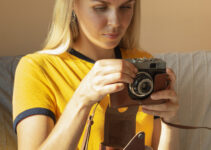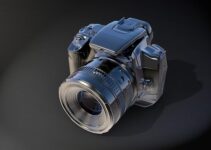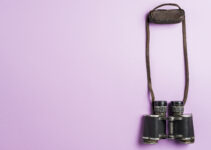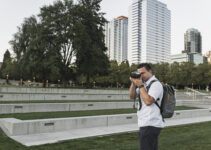Table of Contents
ToggleHave you ever wondered how to securely attach a camera strap to your Nikon camera?
Ensuring that your camera is securely strapped is essential for protecting your valuable equipment while keeping it easily accessible.
Attaching the camera strap might seem like a simple task, but doing it correctly is crucial to avoid any accidents.
This guide will walk you through the process step-by-step, ensuring that your Nikon camera is safe and comfortable to carry.
By following these instructions, you’ll be ready to capture stunning moments with peace of mind, knowing your camera is securely fastened.
Here how make a bean bag for camera support?
Can you attach camera strap Nikon?
To attach a camera strap to a Nikon camera, follow these steps:
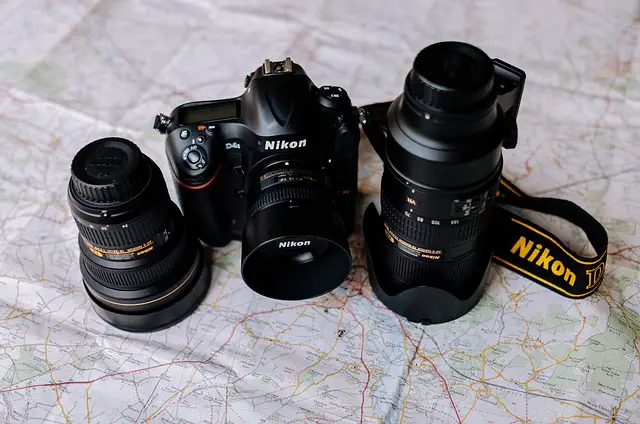
- Locate the Strap Lugs: Identify the metal loops (strap lugs) on each side of your Nikon camera body.
- Thread the Strap: Take one end of the strap and thread it through the strap lug from the bottom. Make sure the Nikon logo on the strap is facing outward.
- Secure the Strap: Pass the end of the strap through the plastic buckle (which is usually part of the strap) to secure it. Then, thread it through the keeper (a small loop on the strap) to lock it in place.
- Adjust Length: Adjust the length of the strap according to your preference, ensuring it’s not too long or too tight.
- Repeat for Other Side: Repeat the process for the other side of the camera.
Always ensure the strap is securely attached to avoid dropping your camera.
Things to know before attaching camera strap Nikon
Before attaching a camera strap to your Nikon, consider these key points:
- Check Compatibility: Ensure the strap is designed for your Nikon model. Some straps may not fit securely or may not be comfortable for your specific camera.
- Inspect the Strap: Look for any signs of wear, fraying, or weak points on the strap. A damaged strap can lead to accidents.
- Understand Strap Adjustment: Familiarize yourself with how to adjust the strap length. It should sit comfortably around your neck or shoulder without restricting movement.
- Secure the Strap: Ensure the strap is properly threaded through the camera’s strap lugs and securely fastened. A loose attachment can cause the camera to fall.
- Comfort and Usability: Choose a strap that is padded and ergonomically designed to reduce strain during extended use, especially if your camera is heavy.
Taking these precautions ensures safety and comfort while using your Nikon camera.
How to attach camera strap Nikon?
To attach a camera strap to a Nikon camera:
Here, what does a camera and money bag emoji means on tinder?
- Locate the Strap Lugs: Find the metal loops (strap lugs) on both sides of the camera body.
- Prepare the Strap: Unfasten the strap by loosening the plastic buckle and threading the strap end out of the keeper loop.
- Thread the Strap: Insert one end of the strap through the strap lug from the bottom, making sure the Nikon logo faces outward.
- Secure the Strap: Pass the strap end through the plastic buckle, then back through the keeper loop. Pull tight to secure it, ensuring there’s no slack.
- Check for Security: Tug gently on the strap to make sure it’s securely fastened. Repeat these steps on the other side of the camera.
- Adjust Length: Adjust the strap length to your preferred carrying style, whether around your neck, shoulder, or across the body.
This ensures your Nikon is securely attached and comfortable to carry.
7 Tips to attach camera strap Nikon
1. Choose the Right Strap
Selecting the correct strap for your Nikon camera is crucial. Opt for a strap that is compatible with your camera model and suits your shooting style. Consider factors like padding, width, and material.
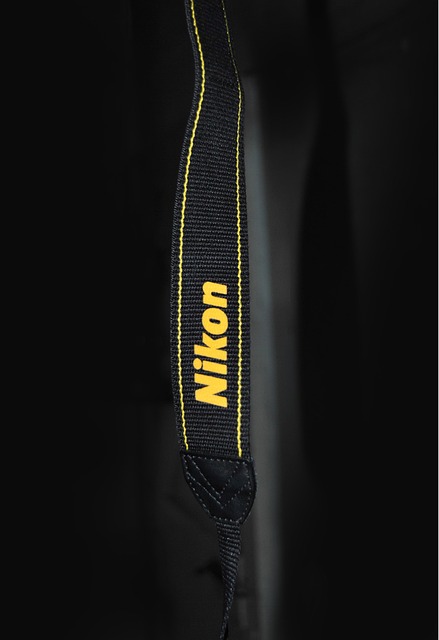
A good strap will provide comfort, especially during long shooting sessions, and reduce strain on your neck or shoulders. Additionally, look for straps with quick-release mechanisms if you frequently switch between hand-held shooting and tripod use.
2. Inspect the Strap and Lugs
Before attaching the strap, carefully inspect both the strap and the camera’s lugs for any signs of wear or damage.
Frayed edges or loose stitching on the strap could compromise its strength, while worn lugs could cause the strap to detach unexpectedly. Ensuring both are in good condition will prevent accidents and keep your camera secure during use.
Here, what size dry bag for camera should you use?
3. Attach with Proper Orientation
When attaching the strap, ensure that the Nikon logo or branding faces outward. This orientation helps you correctly position the strap, so it rests comfortably on your neck or shoulder.
Proper orientation also ensures that the strap’s padding or ergonomic features are used effectively, enhancing your comfort while carrying the camera.
4. Secure the Strap Ends
After threading the strap through the camera’s lugs, properly secure the ends by threading them through the buckle and keeper loop. Make sure there is no slack and that the strap end is firmly in place.
This step is crucial for ensuring that the strap stays attached and doesn’t slip out, especially during active shooting sessions.
5. Adjust for Comfort
Adjust the strap length to suit your preferred carrying style. The strap should allow the camera to hang comfortably at your side, chest, or back without restricting movement.
Regularly check the adjustment to ensure it remains comfortable, especially if you switch between different shooting positions frequently.
6. Test for Security
Before heading out to shoot, give the strap a gentle tug to ensure it’s securely attached. Testing the strap’s attachment points will give you peace of mind that your camera won’t accidentally fall.
Here, how to clean billigham canvas?
It’s a good habit to regularly check the strap’s security, particularly if you’re shooting in active or challenging environments.
7. Consider Additional Accessories
Consider using additional accessories like quick-release plates, which allow for easy attachment and detachment of the strap.
These can be particularly useful if you frequently switch between hand-held shooting and using a tripod. Additionally, you can use strap anchors to provide extra security and prevent the strap from twisting or coming loose during use.
7 Steps to attach camera strap Nikon
1. Locate the Strap Lugs
Start by identifying the strap lugs on your Nikon camera. These metal loops are found on both sides of the camera body, typically near the top. The strap lugs are the points where you’ll attach your camera strap.
Ensure that these lugs are in good condition, free from damage or wear, as they bear the weight of your camera when it’s hanging from the strap.
Properly identifying these attachment points is crucial for a secure connection, as any mistake here can lead to improper attachment and potential damage to your camera.
2. Prepare the Camera Strap
Before attaching the strap, unfasten the strap from its current setup.
This involves loosening the plastic buckle and threading the strap end out of the keeper loop. Make sure the strap is not twisted and that the padded section (if present) is positioned correctly.
Preparing the strap this way ensures that it’s ready to be threaded through the lugs without any tangles or incorrect orientation. Proper preparation is key to a smooth and hassle-free attachment process.
3. Thread the Strap Through the Lugs
Take one end of the strap and thread it through the first strap lug from the bottom up.
The strap should pass through smoothly without any twisting. Ensure that the Nikon logo or branding on the strap is facing outward, so it will be visible when you’re wearing the camera.
Threading the strap correctly ensures that it will lay flat against your body when worn, making it more comfortable to carry the camera.
4. Secure the Strap End
Once the strap is threaded through the lug, it’s time to secure it.
Here, how to put on a tripod strap on a camera bag?
Take the end of the strap and pass it through the plastic buckle, then back through the keeper loop. Pull the strap end tight, ensuring that it’s securely fastened and there’s no slack.
Properly securing the strap end is essential to prevent the strap from slipping or coming loose while you’re using the camera. Double-check that the buckle is tight and that the strap end is firmly in place.
5. Repeat for the Other Side
After securing one side of the strap, repeat the same process on the opposite side of the camera. This involves threading the strap through the lug, securing it through the buckle, and tightening it to eliminate any slack.
Consistency in securing both sides of the strap ensures that your camera hangs evenly and is balanced when worn.
An uneven or improperly secured strap can lead to discomfort and increase the risk of the camera slipping off your shoulder.
6. Adjust the Strap Length
With both ends of the strap securely attached, adjust the strap length to your preferred size.
The strap should allow the camera to hang at a comfortable height, whether it’s around your neck, across your body, or over your shoulder. Make sure the adjustment is tight and that the strap won’t lengthen or shorten on its own during use.
Properly adjusting the strap length enhances comfort and ensures easy access to your camera when you need it.
7. Test the Strap’s Security
Before using your camera, give the strap a gentle tug to test its security. Make sure that both ends are firmly attached and that there’s no sign of slipping or loosening. Testing the strap’s attachment points before heading out for a shoot is crucial to prevent accidents.
Regularly testing the security of your strap, especially after long periods of use or exposure to different conditions, helps maintain your camera’s safety and your peace of mind.
5 Method to attach camera strap Nikon
1. Traditional Two-Point Attachment
The most common method to attach a camera strap to your Nikon involves using the two strap lugs on either side of the camera.
Start by threading one end of the strap through the lug, securing it with the buckle, and repeating the process on the other side.
Here, how to use camera bag dividers?
This method distributes the weight evenly across your neck or shoulders, making it a popular choice for general photography.
It’s simple and effective, providing a secure connection that’s ideal for most shooting scenarios. Always ensure the strap is properly adjusted and secured to avoid any mishaps.
2. Crossbody or Sling Style
For a more ergonomic carrying option, consider attaching the strap in a crossbody or sling style.
This involves using a single strap lug or an additional attachment point, such as a tripod socket, to create a diagonal configuration.

The camera hangs at your side, allowing for quick access while distributing the weight across your body, reducing strain on your neck. This method is particularly useful for street photography or situations where you need to move quickly and want your camera ready at a moment’s notice.
3. Wrist Strap Attachment
If you prefer a more compact setup, a wrist strap is an excellent alternative. To attach a wrist strap, thread it through one of the camera’s strap lugs, securing it firmly.
This method is ideal for lighter cameras or situations where you want a minimalistic approach, such as casual shooting or traveling. A wrist strap allows you to keep the camera secure while maintaining full mobility.
However, it’s less comfortable for prolonged use compared to a neck or shoulder strap, and it offers less protection against accidental drops.
4. Quick-Release Strap System
For photographers who frequently switch between handheld shooting and tripod use, a quick-release strap system is highly convenient.
This method involves attaching quick-release clips or connectors to the strap lugs and the strap itself. You can then easily detach or reattach the strap with a simple click. This setup is particularly useful for professionals who need flexibility and speed during shoots.
Here, how to clean rust from vintage camera?
The quick-release system also allows for easy storage of the strap when not in use, without the hassle of unthreading it from the camera.
5. Shoulder Pad Integration
For added comfort, especially with heavier camera setups, consider using a strap with an integrated shoulder pad. To attach this type of strap, thread the ends through the camera’s strap lugs and secure them as usual.
The key difference is the padded section, which sits on your shoulder, distributing the camera’s weight more evenly and reducing strain.
This method is ideal for long shooting sessions or when carrying additional gear. The padded strap often features non-slip materials, ensuring it stays in place, providing both comfort and security during extended use.
5 Benefits to attach camera strap Nikon
1. Enhanced Security
Attaching a camera strap to your Nikon significantly reduces the risk of accidental drops. The strap acts as a safety net, keeping the camera securely attached to your body.
This is particularly important when shooting in crowded or dynamic environments where a slip could lead to costly damage. With a strap, your camera is always within reach, ensuring it stays safe even when you’re not actively using it.
2. Improved Comfort
Using a camera strap distributes the weight of your Nikon camera across your neck, shoulders, or wrist, reducing strain during extended shoots. This is especially beneficial when carrying heavier camera bodies or lenses.
The strap allows you to carry your camera comfortably for longer periods, minimizing fatigue and ensuring you’re ready to capture the perfect shot whenever it arises.
3. Quick Accessibility
A camera strap keeps your Nikon camera readily accessible at all times.
Whether you’re shooting on the go or in fast-paced environments, having the camera hanging from your neck or shoulder allows for quick and easy access.
This benefit is particularly valuable in situations where moments are fleeting, such as street photography or wildlife shoots, where speed is essential.
4. Versatile Carrying Options
Attaching a camera strap offers versatile carrying options, allowing you to wear the camera around your neck, across your body, or over your shoulder.
Here, how to clean a tenba polyethelene camera bag?
This versatility lets you choose the most comfortable and practical way to carry your camera, depending on the situation. It also helps distribute the weight more evenly, preventing discomfort or strain on a single area of your body.
5. Hands-Free Convenience
A camera strap frees up your hands when not actively shooting, making it easier to perform other tasks, such as adjusting settings, changing lenses, or using additional equipment.
This hands-free convenience is particularly useful when you’re on the move or need to carry other gear.
With the camera securely hanging from the strap, you can focus on other aspects of your shoot without worrying about where to place your camera.
How to take camera strap OFF Nikon
To remove the camera strap from your Nikon camera, follow these steps:
- Locate the Strap Lugs: Identify the metal loops (strap lugs) on each side of the camera where the strap is attached.
- Loosen the Buckle: On one side of the strap, find the plastic buckle that secures the strap. Slide the strap end out of the keeper loop, then loosen the strap by pulling it back through the buckle.
- Unthread the Strap: Once the strap is loose, carefully unthread it from the strap lug by pulling it out from the bottom.
- Repeat on the Other Side: Repeat the process on the opposite side of the camera to fully detach the strap.
- Store the Strap: Once removed, store the strap in a safe place to avoid damage or loss.
This process ensures you can safely and easily remove the strap without damaging your camera.
Related faq’s
What is the Correct Way to Attach a Nikon Camera Strap?
To attach a Nikon camera strap, thread the strap through the strap lugs on both sides of the camera, secure it by passing the end through the buckle, and ensure it’s properly tightened. This method ensures the strap is securely attached and comfortable to wear.
Can I Use Any Camera Strap with My Nikon Camera?
While many camera straps are universal, it’s best to use a strap designed for your Nikon model.
Some straps offer specific features like quick-release mechanisms or extra padding, which can enhance your shooting experience and provide better security.
How Do I Adjust the Length of My Nikon Camera Strap?
To adjust the strap length, simply slide the strap through the buckle to loosen or tighten it.
Ensure the strap is adjusted to a comfortable length, allowing the camera to hang at your desired height, whether around your neck, shoulder, or across your body.
How Do I Prevent My Camera Strap from Twisting?
To prevent twisting, ensure that the strap is flat and properly threaded through the strap lugs when attaching it.
Regularly check that the strap hasn’t twisted during use, as this can cause discomfort and affect how the camera hangs.
Is It Safe to Attach a Heavy Lens to a Camera Strap?
Yes, but ensure that the strap is strong and securely attached.
For heavy lenses, using a padded strap or one with reinforced stitching can help distribute the weight more evenly, reducing strain on the strap and your neck or shoulder.
How Often Should I Check My Camera Strap for Wear and Tear?
It’s advisable to check your camera strap regularly, especially before and after long shoots.
Look for signs of wear, such as fraying, loose stitching, or weakened buckles, to avoid the risk of the strap breaking unexpectedly.
Can I Attach a Wrist Strap Instead of a Neck Strap to My Nikon Camera?
Yes, a wrist strap can be attached to one of the camera’s strap lugs as an alternative to a neck strap.
This is ideal for compact or lightweight cameras and provides a secure grip, though it offers less protection and comfort for prolonged use.
Conclusion
Attaching a camera strap to your Nikon is a straightforward process that enhances security, comfort, and accessibility during shoots.
By threading the strap through the camera’s strap lugs, securing it with the buckle, and adjusting the length, you ensure that the camera is both secure and conveniently positioned.
Regularly checking the strap for wear and adjusting its length as needed will help maintain a safe and comfortable shooting experience.
Whether using a traditional neck strap or an alternative like a wrist strap, proper attachment is crucial for protecting your equipment and ensuring it’s always ready for your next shot.



